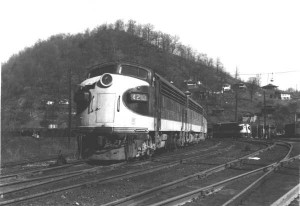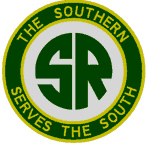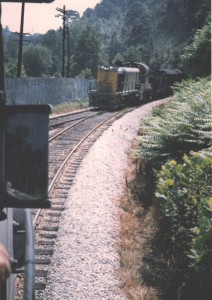- Size: 15′ x 20′
- Scale: HO
- Minimum Radius: 30″ (unless otherwise noted)
- Minimum Aisle Width: 30″
- Designed by Dan Bourque
 The L&N first reached the hamlet of Middlesboro, KY (then Middlesborough) around 1890 on it’s quest to tap the coalfields and build a bridge route to the Norfolk & Western in western Virginia. From Middlesboro, the L&N used (and later acquired) the Southern’s (KCG&L) tunnel near the Kentucky/Tennessee state line at Cumberland Gap to reach Tennessee and then Virginia. For a few decades, this route formed the mainline of the L&N’s Cumberland Valley (CV) Division. The Middlesborough Railroad was constructed to reach a handful of coal mines west of town, and from its outset was operated jointly by the L&N and Southern which reached the branches from Knoxville, TN via trackage rights from Cumberland Gap. In 1930, the L&N completed a tunnel under Cumberland Mountain which joined the CV east of Middlesboro. This route quickly became the preferred mainline, and while still labeled a “main,” traffic on the Middlesboro portion of the CV shrank to mine runs and locals.
The L&N first reached the hamlet of Middlesboro, KY (then Middlesborough) around 1890 on it’s quest to tap the coalfields and build a bridge route to the Norfolk & Western in western Virginia. From Middlesboro, the L&N used (and later acquired) the Southern’s (KCG&L) tunnel near the Kentucky/Tennessee state line at Cumberland Gap to reach Tennessee and then Virginia. For a few decades, this route formed the mainline of the L&N’s Cumberland Valley (CV) Division. The Middlesborough Railroad was constructed to reach a handful of coal mines west of town, and from its outset was operated jointly by the L&N and Southern which reached the branches from Knoxville, TN via trackage rights from Cumberland Gap. In 1930, the L&N completed a tunnel under Cumberland Mountain which joined the CV east of Middlesboro. This route quickly became the preferred mainline, and while still labeled a “main,” traffic on the Middlesboro portion of the CV shrank to mine runs and locals.
The Layout
This double-deck track plan represents Middlesboro, KY and the Middlesborough Railroad in the late 1950s or early 1960s after dieselization but before the large, classic tipples gave way to truck dumps and flood loaders. While the tracks are accurate for the steam era, this plan does not include the wye south of Middlesboro that would be necessary to turn locomotives. The layout is divided into four vignettes. The first vignette on the lower deck represents the mainline through Middlesboro including the small yard and the junction to Cumberland Gap (main) and the branches. The second vignette on the lower level contains Stony Fork Junction on the eastern edge of Middlesboro where the railroad split to serve either the southern mines along Bennett’s Fork near Bryson, TN or the northern mines along the Stony Fork near Capito, KY.
The upper deck is reached via a two track helix. The third vignette is the end of the Bennett Fork branch in Tennessee which split to serve tipples at Delsea, Reliance and Bryson Mountain (torn down in the 1950s). Reliance has been switched to the other side of the track from the prototype to avoid the headache of a hillside along the aisle on the upper level. The final vignette is the end of the Stony Fork branch including three tipples, two of which were reached via a steep switchback. Staging would consist of 6-10 tracks (approximately 15 feet long) in a double-ended yard below Middlesboro which would also provide continuous running.
Construction of this layout would be somewhat complex due to three helixes, two short and one tall, complicated by the stacking of two helixes with opposite turns in the lower right of the drawing (one going clockwise down to staging [B] and the other double track going clockwise up to the tipples [D]). In a few areas, the scenery and track go more than 4 feet deep from the aisle making them hard to reach (Premier, Bryson); to lessen the chance of derailment in these areas, there are no switches more than 30″ from the aisle. The arrangement near Stony Fork Junction adds operational realism, but it requires some steep grades near the Bennett Fork bridge, around 4 percent, to make the elevations back into the helix work. Hand laying switches would be useful due to the number of curves switches. A simple DCC system with walk-around throttles would work due to the small number of trains, but a booster is recommended to power the large amount of track.
Operations
While operations would be modest for the size, this layout could still keep 1-4 operators busy for 3-4 hours. Two-person crews are recommended due to all the switching needed. According to a 1953 timetable, five trains would be run, all in the morning hours: two Southern mine runs, an L&N mine run, and the L&N’s CV local in each direction. L&N mine runs would originate from the Pineville staging side of Middlesboro, and Southern mine runs would originate from the Cumberland Gap staging side of Middlesboro. Power for all trains would be 4-axles (because of the era and because 6-axles were restricted from this portion of the railroad in later years), likely RS3s for the L&N and RS3s, GP7s or F7s for the Southern.
The first train to enter the scene would be Southern 201, arriving at Middlesboro at 4:45 AM to work the mines on the Bennett Fork side, from Gravity to Bryson Mountain. After turning the train in Middlesboro, the mine run would drop off any local cars (for the L&N to set out) and head out, dropping empties along the way and picking up loads on the way back, where it became Southern 202. Each mine could load cars for either the L&N or Southern, but it appears in this time frame that the Bennett Fork side loaded Southern-bound cars. On the heels of 201 was Southern 203, arriving at Middlesboro at 4:55 AM to work the Stony Fork branch, again turning in the yard, heading through Stony Fork Junction and up to Capito and the switchback, dropping empties and picking up loads on the return trip as Southern 204. The mine runs would only pull Southern cars from the tipples.
The first daily L&N train to reach Middlesboro would be the mine run, train 67, which originated at Wallsend Yard (Pineville) at 6:35 AM and reached Middlesboro at 7:35. At Middlesboro, it worked the local industries, and per the timetable, waited for Southern 202 and 204 to return to Middlesboro before designating as 167 and proceeding to Stony Fork Jct and up the Stony Fork branch. During the wait, it might also pick up empty hoppers left in the yard by an earlier train and bound for the local mines. If 167 had any work to do on the Bennett Fork line, the small Gravity Yard would allow it to set off empties for one branch while working the other and to set off loads from the first branch while working the second. On the return trip, the train would be redesignated as 168, and upon reaching Middlesboro, to train 68 where it would follow the CV Local north from Middlesboro at 11:40 AM.
While 67 was handling local switching in Middlesboro, train 91, the CV Local, passed through Middlesboro from Pineville at 7:45 on its way to Cumberland Gap and Hagans (its turning point). The CV Local might stop in Middlesboro long enough to pick up southbound cars including any picked up by 67 from local industries, but in all likelihood, these cars were probably routed north to Pineville to be run down the new CV main to Hagans and Norton. The CV Local would return again at 11:18, this time from the Cumberland Gap side as train 90, stopping long enough to pick up any cars bound for Pineville and points north.
Of course, a lot of variety could be added to this scheme. The most notable being occasional “detour” trains routed over the “old CV” due to work or derailments on the “new CV.” Other variety could be gained by swapping which mines load on which railroad, and when Southern loads are light, running a single mine run instead of two. Likewise, when L&N work is heavy, an extra mine run could be called. Mixing L&N and Southern loads at the same tipple would yield extra switching as well.
Things I Like About this Plan:
- Continuous running option
- Lots of switching
- Three mine runs over the same line
- Some non-coal traffic
- Generous aisles
Things I Don’t Like About this Plan:
- Branches compressed
- Overly steep grades in spots
- Lots of curved switches
- Some tough-to-reach areas
Related Products:








Fascinating layout. The December 2023 issue of the L&NRHS Magaazine has a 17 page article I wrote re the Railroads of Middlesboro which was compressed from a 2-hour workshop I gave at our 2023 Convention.